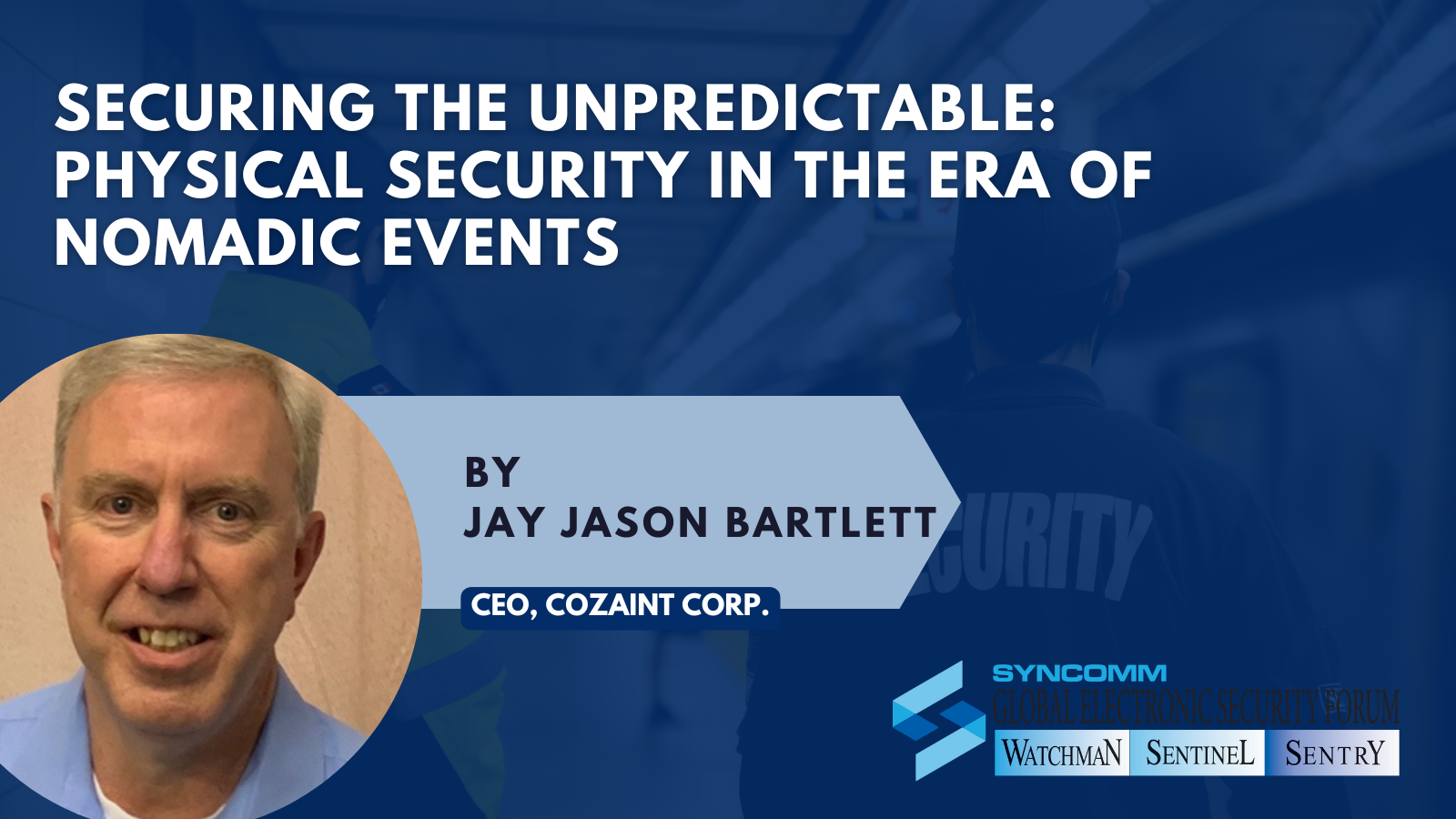
By Jay Jason Bartlett, CEO, Cozaint Corp
The events landscape is changing. The days of gatherings that were venue-bound and predictable are long gone. The number of nomadic or “random” events has increased in recent years, including pop-up festivals, neighborhood park performances, city-wide outdoor events (such as marathons) or even unplanned protests that appear with little notice. These gatherings pose a serious threat to physical security since many are driven by social media and a desire for unusual experiences.
Today’s physical security firms are aware of how difficult it is to keep people and property safe in these uncertain environments. The conventional security paradigm, which depends on fixed infrastructure and pre-established boundaries, is insufficient. To protect guests’ safety and the event’s integrity, security service providers must innovate, adapt, and make use of cutting-edge technologies.
The Unique Challenges of Nomadic Events:
Nomadic events present a confluence of challenges that strain traditional security protocols:
- Lack of Pre-Planning: Organizers often prioritize spontaneity, leaving minimal time for security planning and risk assessments. This makes it difficult to deploy resources effectively and anticipate potential threats.
- Dynamic Locations: Events can shift locations rapidly, making it challenging to establish secure perimeters and monitor crowd movement. This constant flux requires agile and adaptable security solutions.
- Diverse Crowds: Nomadic events often attract diverse crowds with varying motivations, making it difficult to predict behavior and identify potential threats.
- Communication Gaps: Rapidly changing event details and locations can lead to communication breakdowns between organizers, security personnel, and attendees.
- Limited Infrastructure: Temporary or impromptu locations often lack essential security infrastructure, such as lighting, surveillance systems, and access control.
Technology as a Force Multiplier:
To address these challenges, security companies are increasingly turning to advanced technologies:
- AI-Powered Video Analytics: High-resolution surveillance cameras, coupled with AI-powered video analytics, are revolutionizing crowd monitoring. These systems can detect anomalies, such as unusual crowd behavior, abandoned objects, and potential security breaches in real-time. Facial recognition can assist in identifying known individuals of concern.
- IoT Sensors: Internet of Things (IoT) sensors can be deployed to monitor various environmental factors, such as crowd density, temperature, and air quality. These sensors can provide real-time data to security personnel, enabling them to make informed decisions and respond proactively to potential hazards.
- Mobile Surveillance Systems: Deployable, rapidly installed mobile surveillance units, including drones, provide aerial views and wider coverage of the event area. These systems can be equipped with thermal imaging and other advanced sensors to enhance situational awareness.
- Real-Time Communication Platforms: Secure, encrypted communication platforms enable seamless communication between security personnel, event organizers, and emergency services. These platforms facilitate rapid information sharing and coordinated responses to incidents.
- Geofencing and Location Tracking: Geofencing technology can establish virtual perimeters around the event area, triggering alerts when attendees enter or exit designated zones. Location tracking via mobile apps can provide real-time data on crowd movement and identify potential bottlenecks.
- Access Control and Crowd Management: Mobile access control solutions, such as QR code scanning and biometric authentication, can streamline entry and exit processes, reducing congestion and enhancing security. Crowd management software can analyze real-time data to predict crowd behavior and identify potential risks.
The Security Company’s Role: Beyond Technology:
While technology is crucial, it’s only one piece of the puzzle. Security companies are expected to provide comprehensive solutions that encompass:
- Risk Assessment and Planning: Conducting thorough risk assessments and developing tailored security plans that address the unique challenges of nomadic events.
- Trained Security Personnel: Deploying highly trained and experienced security personnel who are adept at crowd management, conflict resolution, and emergency response.
- Situational Awareness: Establishing a robust situational awareness center that monitors real-time data from various sources and provides actionable intelligence to security personnel.
- Collaboration and Communication: Fostering strong communication and collaboration between event organizers, law enforcement, and emergency services.
- Flexibility and Adaptability: Developing flexible and adaptable security strategies that can be adjusted in response to changing event dynamics.
- Liability and Insurance: Providing adequate insurance coverage and managing liability risks associated with event security.
- Post Event Analysis: Providing detailed post event analysis to improve future security measures.
The Organizer’s and Security Company’s Joint Challenges:
Nomadic events create a unique symbiotic relationship between organizers and security companies. Both parties face challenges. Organizers often don’t understand the full scope of security risks, and security companies must rapidly adapt to the organizer’s often fluid plans.
This requires:
- Clear Communication: Establishing open communication channels and clearly defining roles and responsibilities.
- Shared Risk Assessment: Working together to conduct thorough risk assessments and develop comprehensive security plans.
- Rapid Deployment: Security companies must be prepared to deploy resources quickly and efficiently.
- Budgeting: Organizers must understand the cost of security and allocate sufficient resources.
- Contingency Planning: Both parties must work together to develop contingency plans for various scenarios.
In today’s nomadic events environment, a paradigm shift in physical security is required due to the increase of such events. Security firms may successfully safeguard individuals and property in these uncertain situations by adopting cutting-edge technologies, encouraging teamwork, and placing a high value on adaptability. Security firms must stay on the cutting edge of innovation to guarantee the safety and security of every guest as the demand for unusual and impromptu experiences keeps rising.
About The Author:
Jay Jason Bartlett is the Managing Editor of Security.World and the CEO of Cozaint Corporation, a manufacturer of security surveillance solutions. Jay has over 40 years in the high-tech industry and over 15 years in physical security. visit: cozaint.com

